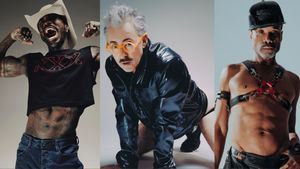World
CONTACTAbout UsCAREER OPPORTUNITIESADVERTISE WITH USPRIVACY POLICYPRIVACY PREFERENCESTERMS OF USELEGAL NOTICE
© 2025 Pride Publishing Inc.
All Rights reserved
All Rights reserved
By continuing to use our site, you agree to our Private Policy and Terms of Use.
Postcards from Egypt
The Nile as it
winds through Aswan
Whether inside a pyramid or at a Nileside cafe, a gay American tourist in Egypt needs to step carefully.
Tomb of Darkness
The Pyramids
I am inside the Great Pyramid of Giza, at the pinnacle of a 460-foot stairway to heaven. And I am in total, pitch-black darkness.
To get out of here will depend as much on a sense of faith as on a sense of balance.
My mind rewinds to the recent ascent--hundreds of steps angled at a dizzying 52-degree pitch. At some points during the climb up the pyramid, I literally have to get on my hands and knees to crawl through the narrow tunnel of limestone lifting me to the gods.
It doesn't help that I make this trip in June. Outside the temperature must be 100 degrees, and inside the air is not much cooler. Dim rows of flickering fluorescent lamps spaced periodically up the ancient shaft provide the only lighting. In many places there are no handrails. Underfoot, rickety wood slats have been laid over the grand stones that first raised men's bodies and spirits to what 4,600 years ago must have seemed like the top of the world.
Trending stories
It still does.
The climb is well worth the effort, but not simply to see the smoothly sanded red granite tomb at the top known as the King's Chamber. Though the room is an engineering feat in any age -- the granite roof alone weighs more than 400 tons --it is visually plain and unimpressive. The reasons to climb the Great Pyramid are less tangible than anything you could photograph. They have to do with mystery and adventure, history and spirituality, the greatness and sorrow of a lost civilization, and the mythological imagery that the sole survivor of the ancient world's Seven Wonders holds in the popular imagination.
As I begin my descent, I stand on the precipice of the King's Chamber and stare down into the dimly lit passage. It feels like I am staring back into time itself, and I wonder what it must have been like for the ancient Egyptians who had to make the treacherous climb without the aid of electricity, however flickering it might be.
And that's when the lights go out.
I freeze. Though there are perhaps a dozen tourists stuck with me, for a long moment it is eerily silent, and I am reminded that this great monument is first and foremost a tomb.
Then a splash of light beams its way up from about 20 feet below. It is our Egyptian tour guide, equipped with a flashlight.
"Hold hands and follow me slowly," he says to the seven of us together on this trip.
Electrical failure is apparently not unusual, and our guide's nonchalance about it is oddly reassuring. To my amazement I find myself complying with his instructions to proceed. I am the last of the seven in our troupe. We inch our way down together, one unsure step after the other, the flashlight beam acting like a beacon.
My alarm subsides, and a weirdly American thought races through my mind: "If this were the United States," I ponder to myself as I negotiate the unseemly gradient in the grayness, "just think of the lawsuits."
Great hairdos at Abu Simbel, the temple of Ramses IIThe temple of Ramses IIThe next morning I meet my travel companions in the hotel lobby at 2:45 a.m. We are up before dawn to catch our Egypt Air flight from Cairo to Abu Simbel, at the southernmost point of Egypt's border with Sudan. Summer flights leave at an ungodly hour in order to deposit tourists at the monument while they can still withstand the withering heat.
By the time we hike on foot the final dusty mile to the monument, it is about 9 a.m., and the heat is already causing me to bead with sweat.
The trail slopes and curves dramatically down from the crest of the mountain, where merchant's stalls are huddled. To one side, rock desert mountains in hues of yellow and pink stretch as far as the eye can see. To the other, the jagged and barren mountain ranges plummet forcefully into the endless expanse of the pristine blue Lake Nasser--the world's largest man-made lake, created by damming the Nile further north at the High Dam.
During the descent to Abu Simbel, the temple of Ramses II is obscured. Only when I reach the bottom of the trail does the colossal temple carved into the mountain show itself. I literally stop in my tracks.
In front of me are four gigantically crowned statues of Ramses II, for whom the temple was erected. Each statue is etched 70 feet high into the side of the mountain, and in each one Ramses's hands are resting calmly on his knees, his serene gaze fixed out over the lake. One of the masterpieces of ancient Egypt, the temple dates back approximately 3,050 years. When famed Swiss explorer John Lewis Burkhardt stumbled across it in 1813, only one of the four heads was peeking out over the sand drift that had engulfed it.
But perhaps the greatest recovery of the temple was its most modern one. You could never tell by looking that the original site was actually built some 200 feet below where the quadruple Ramses now stare transfixed in time. When the High Dam project began in the 1960s, this site was one of countless treasures that were threatened with drowning under Lake Nasser. Thanks to an international effort, however, the mountainside monument was carefully chopped into more than a thousand pieces and painstakingly reassembled at its current site.
Just next door is the Temple of Queen Nefertari, supposedly Ramses's favorite wife. This temple is slightly smaller but similarly carved from top to bottom with hundreds of the geometric and animal-shaped hieroglyphs that are the signature of Egypt's great past. As I stand there trying to be reverential--as one is wont to do in such a setting--I begin to giggle. My eye has settled on a carving of the goddess Hathor, wife of the sun god, and I can't help but notice that her hairdo is the splitting image of Marlo Thomas's in That Girl!
"The Nile is Egypt, and Egypt is the Nile" The Nile at LuxorI am watching the murky Nile flow by from my perch at the bow of a small, wobbly wooden boat with a single large sail. No trip on the Nile is complete without a jaunt in one of these famous old boats, called feluccas. The tourist trade has inspired a rash of imitations--cleaner, lighter, larger polystyrene impostors without even half the ambience.
When searching for a genuine felucca, there are a handful of easy-to-spot signals that will tell you if you are getting the real adventure or a sanitized mutant of it. But the biggest clue is simply your gut: If you get on a boat and it feels solid and sturdy, get off. A real felucca is a little unnerving: It should creak when you step onto it.
Our captain is a man named Mahmoud. His head is tied in an unwieldy turban-like cloth and he is wearing a flowing white galabia, the common robe worn by men. When we shake hands, I'm struck by his rough skin. His face is weathered and creases deeply around his eyes when he smiles and laughs, which he does constantly. Like most experiences in Egypt, a ride on a felucca is at least partly about faith, be it in the pharaohs or Allah. I settle into our felucca, painted an optimistic orange, and leave the rest to Mahmoud and the gods.
The boat sits so low in the river and the water laps so high it almost spills over the edge. An old Egyptian saying, roughly translated, says, "The Nile is Egypt, and Egypt is the Nile," and it remains true today. From the felucca, I watch Egyptians on the shore using the river for every imaginable need: Farmers use it to water their fields, and sometimes you can see irrigation canals growing like fingers directly from the banks of the river to nourish crops. At another point a woman with a large basket on her head comes to a halt, unloads her cargo, and starts washing clothes. And all along the banks, young boys dip into the river for a little relief from the brutal heat. And though I don't witness it myself, it's well-known that Egypt's poorest residents use the river as a toilet too.
I use my broken Arabic to ask Mahmoud about the water's safety. He swears that here in Aswan, our first port town on the Nile, the water is clean and safe. To prove his point, he pulls out a glass, dips it into the river, and gulps down the contents.
A strong cup of coffee and a date with Ramses Cafe lifeEgypt comes alive in the evenings. All during my cruise on the Nile, from the start in Aswan to the endpoint in Luxor, it is the same: When the sun starts to recede, the dusty, overheated, sometimes even desolate-looking mud-brick villages and towns begin to pulse with life. Shops of all kinds stay open until very late, and contrary to popular Western misconception, women can be seen on the streets well into the night hours as well.
It is true, however, that you see few single women out alone. Most are mothers with their children or women with their husbands strolling the streets or eating with their families. But there's no denying that Egypt is a male-dominated culture, and at night it feels as if hundreds of men spill into sidewalk cafes, drinking tiny cups of strong Arab coffee, puffing on water pipes, and playing backgammon. There is a strongly homoerotic component to this overwhelmingly male display of public life.
I am carrying Ramses on my shoulder, and he's getting heavy. Three feet tall and solid granite, Ramses is my proud midnight purchase the evening we dock in a town along the Nile called Edfu. It takes a long time to get Ramses. To show the shopkeeper I understand the intricate culture of bargaining, I indulge in the ceremonial practice of swapping life histories, debating politics, and sharing the customary glass of sweet mint tea. An hour later I walk out with Ramses tightly wrapped in brown cardboard and string like a modern-day mummy.
It is another half mile to the cruise ship when I decide I need a break. Most of the shops have closed, but the coffeehouses are still teeming with men out for the night.
You have to be careful, of course. Homosexual activity is something that is common but fiercely denied in Egypt. And I am keenly aware of the government's crackdown in Cairo on gay men in the infamous Queen Boat incident. Though there is no law specifically forbidding gay sex, social custom frowns on it if it is expressed too openly, too publicly. But there is no mistaking the meaning of the heavy stares and subtle gestures exchanged at such meeting places.
Cairo at nightI pick one of the busy coffee shops with a sprawling patio. I have no conscious intention of cruising, but I do like to look at the handsome Egyptian men with their tanned skin, thick black beards, and smoldering, sensuous eyes.
It isn't long after ordering a demitasse of coffee and a coal-fired water pipe that I feel the weight of Ahmad's stare from the next table. He approaches me with the characteristic friendliness of most Egyptians. Ahmad is 25 and stocky with a stubbly beard. He and I have met before. Earlier in the evening I purchased a few souvenir T-shirts at a store owned by his family. He remembers my name and sits down at the table with me, using Ramses as an easy conversation starter.
It is 1:45 a.m. when the conversation steers towards relationships. Am I married? He wants to know. Ahmad wants to get married as soon as he can, but at 25, he can't yet afford a dowry. Is that why I'm not married either? He presses. Or don't I like women?
I like women, fine, I say, but I won't ever marry. I know he understands what I mean.
Ahmad buys us another round of coffees and smokes. When we finish round two, Ahmad invites me to a "party." Skeptical, I look at my watch. It's the summer, he says, and people will be up until 5 a.m. I flirt with the notion of accompanying him, but demur, conveniently holding out Ramses as an excuse.
"Ramses is welcome to come," laughs Ahmad. "He can join us."
I smile not just at the subtle but intended,double entendre, but also at the notion of making love with the hard phallic pharaoh at my feet.
"Thank you," I say finally. "But Ramses isn't into threesomes."
Dahir is an editorial writer at the St. Louis Post-Dispatch.
Recommended Stories for You
From our Sponsors
Most Popular
31 Period Films of Lesbians and Bi Women in Love That Will Take You Back
December 09 2024 1:00 PM
18 of the most batsh*t things N.C. Republican governor candidate Mark Robinson has said
October 30 2024 11:06 AM
True
After 20 years, and after tonight, Obama will no longer be the Democrats' top star
August 20 2024 12:28 PM
Trump ally Laura Loomer goes after Lindsey Graham: ‘We all know you’re gay’
September 13 2024 2:28 PM
Melania Trump cashed six-figure check to speak to gay Republicans at Mar-a-Lago
August 16 2024 5:57 PM
Latest Stories
Florida Gov. Ron DeSantis appoints Ashley Moody as Marco Rubio's replacement in the Senate
January 16 2025 6:17 PM
Durk Dehner steps down from Tom of Finland Foundation after Nazi controversy
January 16 2025 4:48 PM
Health and Human Services takes stand against nonconsensual intersex surgeries
January 16 2025 7:59 PM
EDM revolution: Anyma's residency at Sphere in Vegas
January 16 2025 6:00 PM
Megyn Kelly rants about 'obese' lesbians when talking about L.A. fires
January 16 2025 3:35 PM























































































